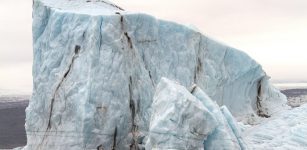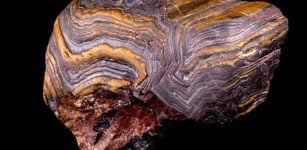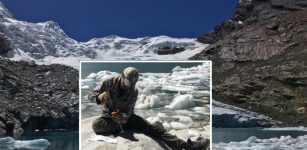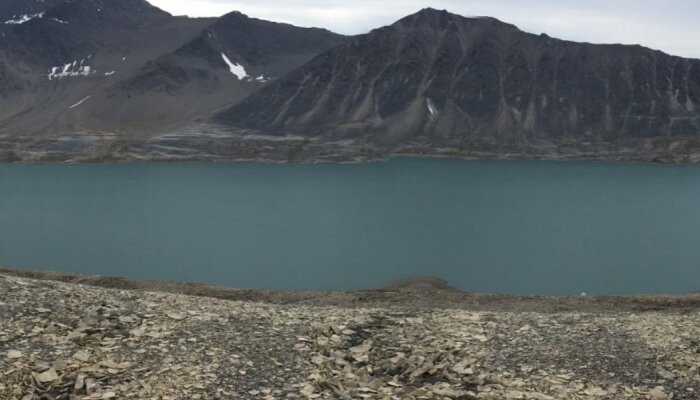The Phenomenon Of ‘Atmospheric Blocking’ – A Major Contributing Factor To The Alarming Rate Of Arctic Ice Loss
Eddie Gonzales Jr. – MessageToEagle.com – A team of scientists led by François Lapointe, a research associate at the University of Massachusetts Amherst, has combined paleoclimatic data from the last 2,000 years with powerful computer modeling and in-the-field research on lake sediments and tree rings.
Lake Linné, on the west coast of Svalbard, where much of the field work was done. Credit: UMass Amherst
The study focused on the Norwegian Arctic archipelago, Svalbard, at the edge of the Arctic Ocean, shows that an understudied phenomenon, known as atmospheric blocking, has long influenced temperaure swings in the Arctic.
As temperatures warm due to climate change, atmospheric blocking will help drive ever-wilder weather events.
It is well known that the Arctic is warming faster than the global average, a phenomenon known as Arctic Amplification. But, since 1991, Svalbard has experienced a warming trend that is double the Arctic-wide rise in temperature. Consequently, the archipelago has been experiencing massive loss of ice, extreme rainfall events and landslides.
“We wanted to know why Svalbard has been warming so much faster than the rest of the Arctic,” says Raymond Bradley, Distinguished Professor at UMass Amherst and co-author of the study, “and to figure out whether or not these trends would continue.”
To do so, they turned to lake sediments from Lake Linné, on the west coast of Svalbard, to help them reconstruct warm and wet conditions during the past 2,000 years. What makes this lake unique is the presence of instruments that have been deployed since 2012 by UMass Amherst alumnus and co-author, Michael Retelle, currently professor of earth and climate sciences at Bates College.
These instruments track the precise timing of sediment entering the lake each year. Sediment pours into the lake during the increasingly frequent freak rainstorms.
Lapointe and his team looked at the calcium levels in Lake Linné’s sediments. Because much of the eastern terrain surrounding the lake is composed of carbonate-rich soil, intense rain events mean that carbonate washes into the lake, settles into the sediment on the lake bottom, and can be measured in sediment cores as a record of rainfall stretching back approximately 2,000 years.
When Lapointe and his colleagues compared all these historical and contemporary observations to the meteorological record, they found a stunning correlation.
“The biggest rain and warming events of the past are all linked to atmospheric blocking over Scandinavia and the Ural Mountains. Atmospheric blocking is when a high-pressure system, with air rotating clockwise around it, stalls over a particular region—in this case northern Scandinavia. In tandem with this high-pressure system, rain events in Svalbard are also often associated with a low-pressure system that settles in over Greenland, which rotates counter-clockwise,” Lapointe says.
The two systems spin like a pair of intermeshed gears, drawing warmer, moister air up from the mid-Atlantic Ocean into the Arctic, leading to downpours of rain in Svalbard. Since observational measurements started, blocking in the Arctic has increased, as has Arctic warming.
“It will be very interesting to observe how atmospheric blocking behaves with further warming,” adds Lapointe. “Any further increase will likely amplify the effects of floods and natural hazards in Svalbard.”
Such projections for Svalbard’s future are concerning. Though the archipelago has a year-round population of just 2,650, the islands’ breathtaking landscapes and unique wildlife attract over 130,000 visitors a year.
Written by Eddie Gonzales Jr. – MessageToEagle.com Staff Writer
Related Posts
-
 Magma Detected Beneath Dormant Cascade Volcanoes
No Comments | Feb 3, 2025
Magma Detected Beneath Dormant Cascade Volcanoes
No Comments | Feb 3, 2025 -
 Study Presents New Clues About The Rise Of Earth’s Continents
No Comments | May 5, 2023
Study Presents New Clues About The Rise Of Earth’s Continents
No Comments | May 5, 2023 -
 Evidence Of World’s Oldest Glaciers – Found
No Comments | Jul 14, 2023
Evidence Of World’s Oldest Glaciers – Found
No Comments | Jul 14, 2023 -
 Iron-Rich Rocks Unlock New Insights Into Earth’s Planetary History
No Comments | May 26, 2023
Iron-Rich Rocks Unlock New Insights Into Earth’s Planetary History
No Comments | May 26, 2023 -
 Mercury Rising: Study Sheds New Light On Ancient Volcanoes’ Environmental Impact
No Comments | Mar 1, 2024
Mercury Rising: Study Sheds New Light On Ancient Volcanoes’ Environmental Impact
No Comments | Mar 1, 2024 -
 How Current Ice Melting Will Affect Levels Around The World – Study
No Comments | Mar 25, 2025
How Current Ice Melting Will Affect Levels Around The World – Study
No Comments | Mar 25, 2025 -
 Antarctic Sea Ice – Key Predictor Of Accelerated Ocean Warming
No Comments | Oct 4, 2025
Antarctic Sea Ice – Key Predictor Of Accelerated Ocean Warming
No Comments | Oct 4, 2025 -
 Andean Glaciers Melt Fast – They Have Shrunk To Their Smallest Size In More Than 11,700 Years
No Comments | Aug 2, 2024
Andean Glaciers Melt Fast – They Have Shrunk To Their Smallest Size In More Than 11,700 Years
No Comments | Aug 2, 2024 -
 Mohonk Lake Research: What 92 Years Of Data Say About Ice Cover
No Comments | Dec 17, 2024
Mohonk Lake Research: What 92 Years Of Data Say About Ice Cover
No Comments | Dec 17, 2024 -
 Earth’s Oxygen-Rich Atmosphere And The Late Evolution of Animal Life – New Theory
No Comments | Jun 5, 2023
Earth’s Oxygen-Rich Atmosphere And The Late Evolution of Animal Life – New Theory
No Comments | Jun 5, 2023

